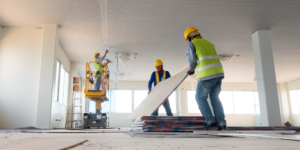Library
Construction Educational Library
Preconstruction | Health & Safety | Finance & Accounting | Risk Management | Capital
A collection of free guides, tools, and expert coaching for construction professionals. Brush up on the fundamentals, or dig deeper with advanced topics in preconstruction, financial management, risk management, health & safety, and more.
Preconstruction
Project success starts during planning. Learn how to develop accurate estimates, write winning bids, and prequalify the contractors you hire.

Don’t Underestimate the Estimator: Key Responsibilities of Construction Estimators
In construction, the estimator’s role is fundamental to project success....

Pro Forma Explained: How Construction Developers Predict Financial Success
Understanding the financial nuances of construction projects requires a deep...

Bid Security in Construction: How Project Owners & Contractors Benefit
For project owners, the construction bidding process is a complicated...

Successfully Navigating Public-Private Partnerships in Construction
A Public-Private Partnership (PPP or P3) is a contractual agreement...
Finance & Accounting
Learn how construction businesses effectively manage working capital, accounting processes, and company growth.

7 Tips to Improve Accounts Payable in Construction
The importance of accurate accounts payable and other accounting records...

The Construction Bidding Process Explained
Understanding how the construction bidding process works can help your...

The 5 Key Types of Construction Contracts
There are five common types of construction contracts: lump sum...

Contractor Financing: The Complete Guide
The financial success of a construction business depends largely on...
Health & Safety
Construction is a dangerous industry. Take steps to make your jobsites safer for workers, analyze data to predict and mitigate future risks, and comply with government regulations.

Jobsite Security: Assessing and Minimizing Construction Site Risks
Assessing security needs for a construction site early can save...

Creating a Culture of Safety in Construction
In construction, a positive safety culture impacts a company’s productivity,...

9 Tips for Effective Subcontractor Management
Subcontractor management, the overseeing, supervision and coordination of subcontractors, profoundly...

How to Leverage Construction Field Reports for Project Success
In the fast-paced and complex construction world, effective documentation is...
Risk Management
Learn how to identify, mitigate, and manage the variety of risks construction businesses face in the industry.

10 Common Construction Risks for Contractors & Owners
Construction is a tough, often volatile industry, with one of...

Builder’s Risk vs. General Liability for Contractors: What’s the Difference?
Construction businesses need many different types of insurance to mitigate...

Performance Bonds for Construction Explained
Performance bonds provide a guarantee that a contractor will fulfill...

Contractor Bonds vs. Insurance: What to Know
As a contractor, it’s important to have the right protections...
Recent Articles

Contract Precedence: A Clause to Clear Construction Confusion
Construction contracts are usually lengthy and complicated, composed of a...

A Contractor’s Guide to Working With Construction Union Labor
In the construction industry, unions play a critical role, bringing...

Jobsite Security: Assessing and Minimizing Construction Site Risks
Assessing security needs for a construction site early can save...

Understanding As-Built Drawings in Construction
At the end of a construction project, owners want to...